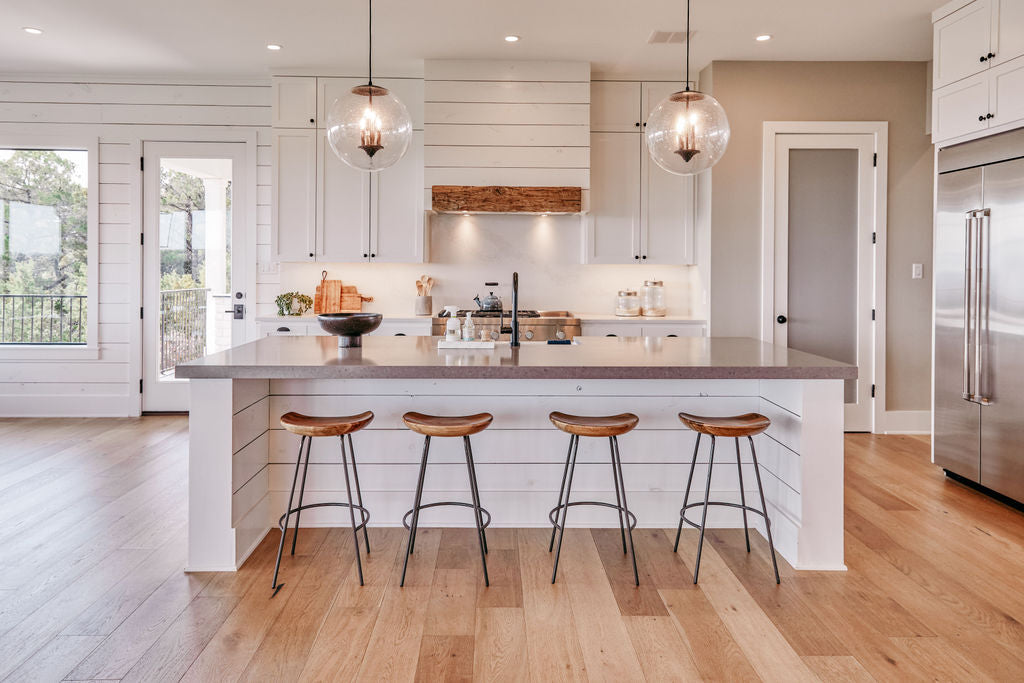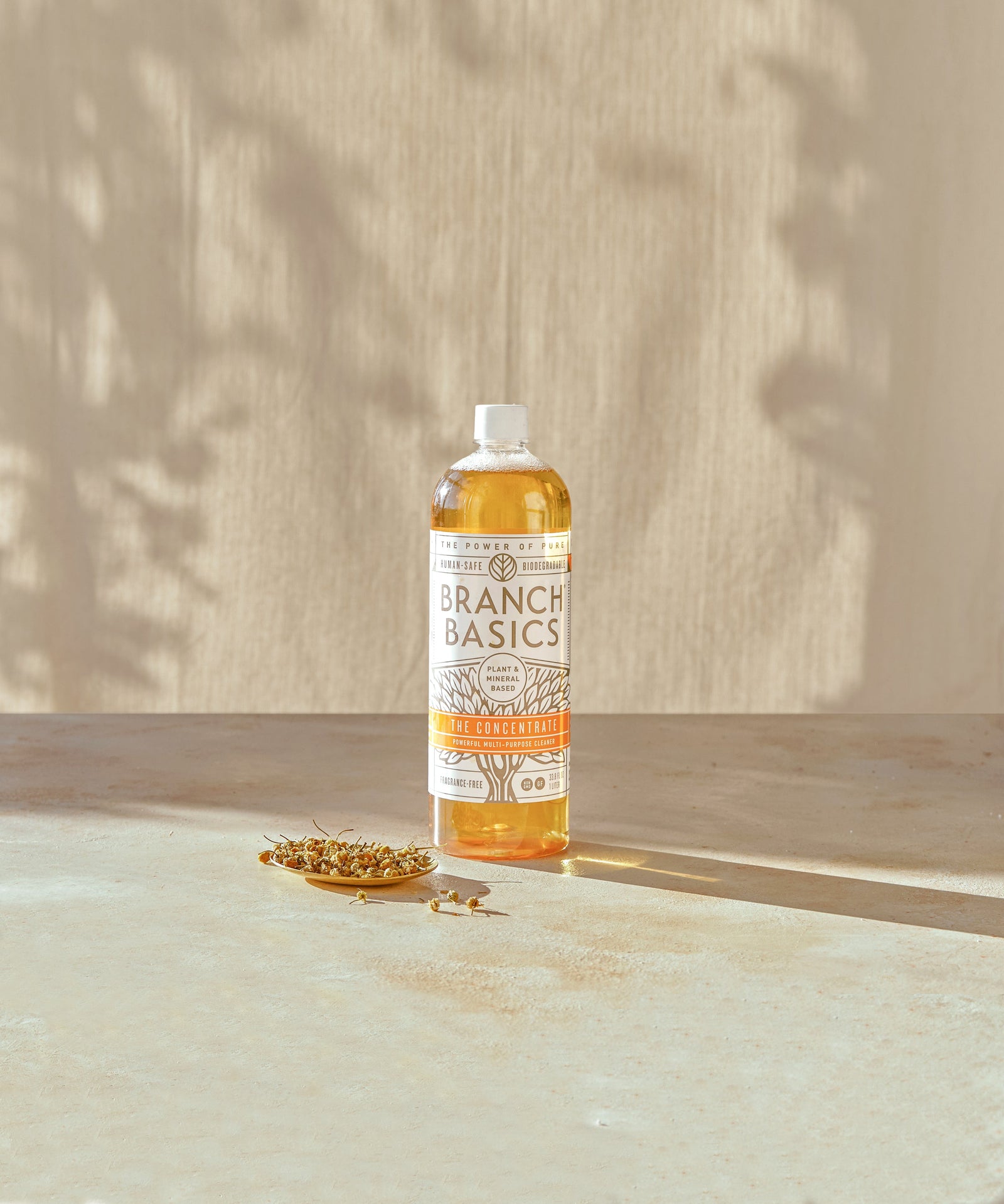How To Clean Wood Naturally

Shoes, humans, and pets, bring in and leave dirt, grime, and illness-causing bacteria on hardwood floors (well, any floors for that matter!). To preserve their shine and prevent buildup, it’s important to regularly clean and maintain your wood floors.
In this article, you’ll learn how to clean wood naturally using human-safe products and homemade methods without the need for harsh chemicals.
How to Clean Wood With Branch Basics
Hardwood floors can easily be damaged by harsh floor cleaners, which is why cleaning experts recommend using hardwood-specific floor cleaners and DIY options instead.
Branch Basics, or a similar all-purpose alternative, is ideal for most urethane/acrylic/polyurethane/UV cured synthetic floor finishes because it is a natural, non-acidic,, surfactant based cleaner.*
Here’s how to use Branch Basics and water to clean wood floors naturally:
- HEPAvacuum up any loose dirt in the room.
- Some people prefer to use a dry swiffer or microfiber cloth to pick up small particulates vacuuming may have missed.
- Use a very diluted solution of Branch Basics Concentrate on sealed wood floors as more concentrated solutions may break down the finish. Typically use ⅛ - ¼ teaspoon of the Concentrate per 2 cups of water.
- Minimize use of water on wood floors by spraying the solution onto a slightly damp mop or microfiber mop to clean the floor. Avoid directly spraying a wood floor.
-
To avoid over wetting the wood floor, never directly spray dirt and grime spots on a wood floor.. Lightly spray diluted solution on a microfiber and wipe clean.
-
To clean wood furniture, spray amicrofiber cloth with the soapy solution. . Lightly wipe over the wood furniture - do not saturate and let air-dry.
- If you see any wet spots, wipe dry with a microfiber cloth.
*Note: Always test a small, inconspicuous area before cleaning an entire space.
Hardwood floors with a natural oil or wax finish should only be cleaned with the manufacturer’s recommended cleaner. Branch Basics is likely to remove natural finishes.
How to Clean Wood With Homemade + DIY Options
To clean wood floors and furniture naturally, common kitchen staples like vinegar, olive oil, lemon juice, and even black tea safely and effectively remove dirt and grime. In addition, these homemade cleaning options can restore shine, bringing out the wood’s natural warm tones.
Here are some homemade and DIY options for cleaning wood naturally.
Olive Oil, Vinegar, and Lemon Juice
Together, olive oil, vinegar, and lemon juice shine, moisturize, and naturally disinfect hardwood floors.*
Here’s how to clean wood naturally with these three ingredients:
- HEPA vacuum up any loose dirt on the floor.
-
Consider a dry microfiber/swiffer mop next.
-
Mix ¼ cup olive oil, ½ cup distilled white vinegar (apple cider vinegar can be used for dark woods), and 1 tbsp. lemon juice together in a mop bucket. Increase the mixture amount as needed.
-
Spray to dampen a microfiber mop with the mixtureto clean wood floors.
- Let air-dry. Wipe any wet spots with a microfiber cloth.
This mixture can also be used on wood furniture. To clean wood furniture naturally, lightly dampen a microfiber cloth in the mixture and wipe over the wood. Let air-dry.
*Note: Vinegar is not recommended for use on waxed wood floors. If you’re unsure, test the cleaning solution in a small, inconspicuous area of the wood to observe its effects.
Black Tea Solution
The tannins found in black tea brighten and restore shine while helping to bring out the warm natural tones in hardwood floors.*
Here’s how to use black tea to clean wood floors naturally.
-
Bring a large pot of water to a boil. While you wait, HEPA vacuum up any loose dirt on the floor.
-
Add 5 to 10 black tea bags to the boiling water. Let steep for about 8 to 10 minutes.
-
Pour the tea into a mop bucket and add some cool, clean water to dilute as needed.
-
Dip a microfiber mop into the bucket and wring out.
-
Mop floors along the wood grain. Wipe dry with a microfiber towel or cloth.
*Note: Always test on an inconspicuous spot to ensure the tea does not stain your wood floors.
Related Read: How to Clean & Disinfect a Wood Cutting Board
Safely Cleaning Hardwood Floors
Hardwood floors require a deep cleaning every once in a while to remove stains and protect the floor’s finish.
Fortunately, there are safe and natural alternatives, like Branch Basics, to harsh chemical cleaners known to negatively affect indoor air, wreaking havoc on your health.
Learn more about safe, natural, and effective cleaning methods for all floor types in our blog, 7 Floor Cleaner Alternatives for a Human-Safe Home.
The Problem With Harmful Wood Cleaners
According to the National Capital Poison Control Center, the following harmful chemicals are often found in conventional wood cleaners, and should be avoided:
-
Hydrocarbon or Stoddard solvent-based floor cleaners - These chemicals can cause neurological issues such as headache, dizziness, lightheadedness, respiratory issues and more. Stoddard solvents can also cause irritation to the eyes, skin, mouth, and throat.
- Anionic surfactants - irritate the skin, nose, and eyes. They may cause developmental and reproductive issues, cardiovascular effects, thyroid disruption, etc. If swallowed, these chemical surfactants may cause gastrointestinal issues, including nausea, vomiting, and diarrhea
-
Glycol ether solvents - This is the most common chemical found in wood floor cleaners. They can be absorbed by the skin or inhaled as volatile fumes causing headaches, shortness of breath, pulmonary edema, abdominal pain and more. If ingested, these chemicals may cause “significant human toxicity, including altered mental status and metabolic disturbances”.
-
Isopropyl alcohol - May cause irritation of the nose and throat, bronco constriction, hypotension and bradycardia. Inhalation can also cause headaches, nausea, vomiting and other neurological effects. When ingested, it can cause nausea, vomiting, abdominal pain, and gastrointestinal bleeding.
-
Citric acid - May cause irritation to the eyes, skin, and stomach.
- Alkaline agents - Can cause severe burns internally if swallowed, or if exposed to the skin and eyes.
To avoid these harmful chemicals, we recommend using the products and DIY options listed in this article, or use our vetting method in 3 Tools You Need To Become Your Own Product Advocate.
Branch Basics is different (in a pure and natural way!). Branch Basics is a simple, human-safe cleaning system that replaces conventional chemical-based wood cleaners.
Here’s why in one of our popular FAQs:
Q: How will I know if All-Purpose is strong enough for the job?
A: Our general rule of thumb is that All-Purpose is the first line of defense for everyday cleaning of surfaces, stains, and more.
Toss The Toxins with Branch Basics
Now that you know how to clean wood naturally without harmful chemicals, let’s talk about our human-safe cleaning products!
Branch Basics is a multi-purpose, human-safe cleaning system that utilizes one natural Concentrate to replace every cleaner and laundry product in the home.
Here’s how it works:
We recommend starting with a Branch Basics Premium Starter Kit. You’ll receive the Concentrate, Oxygen Boost, and five reusable bottles (either plastic or glass) to make your own All-Purpose, Bathroom, Streak-Free, Laundry, and Foaming Wash.
Branch Basics products are Made Safe Certified, not tested on animals/cruelty-free, and safe for pets, babies, children, and the chemically sensitive.
To read more about safe and natural floor cleaning, check out:

Marilee Nelson
Marilee Nelson is an Environmental Toxins expert who has spent nearly 30 years advocating for the chemically-sensitive and chronically-ill. She is a Board Certified Nutritionist, Certified Bau-Biologist and Bau-Biology Inspector and specializes in Food As Medicine. She has helped thousands of families and individuals identify, heal and recover from toxic exposures and is on a mission to revolutionize the way American families view their health.








